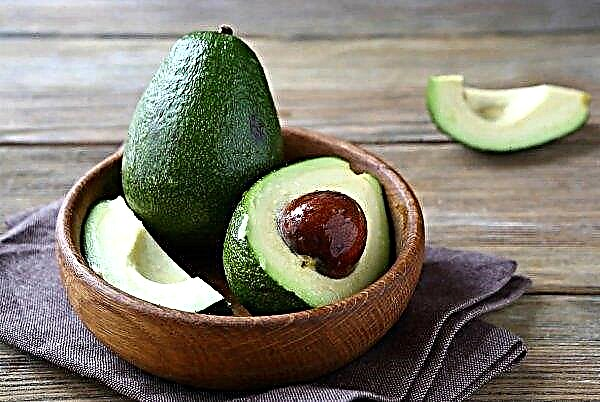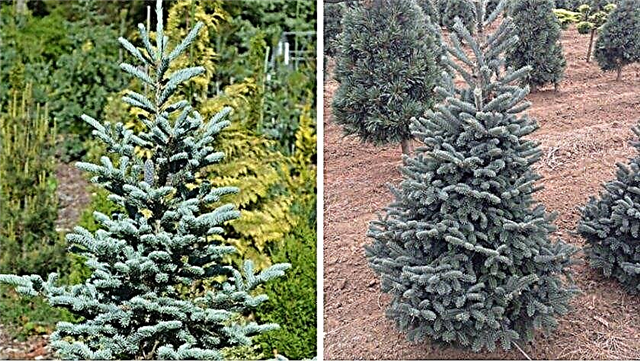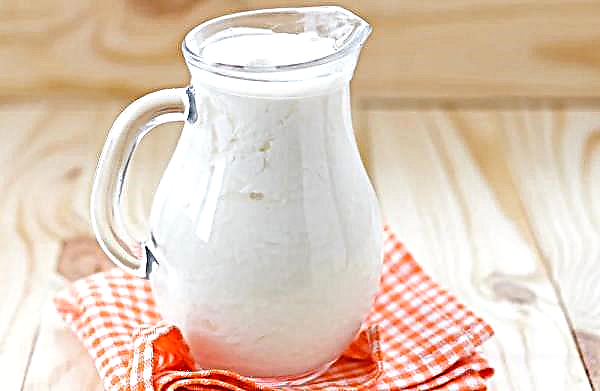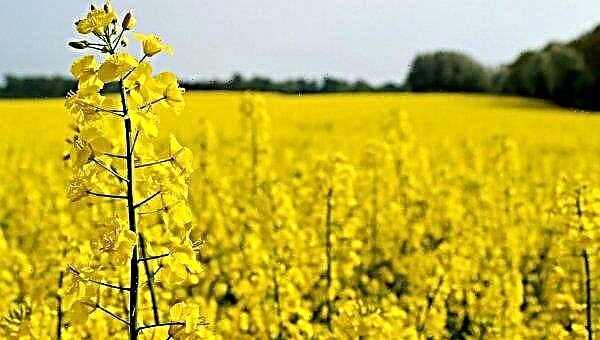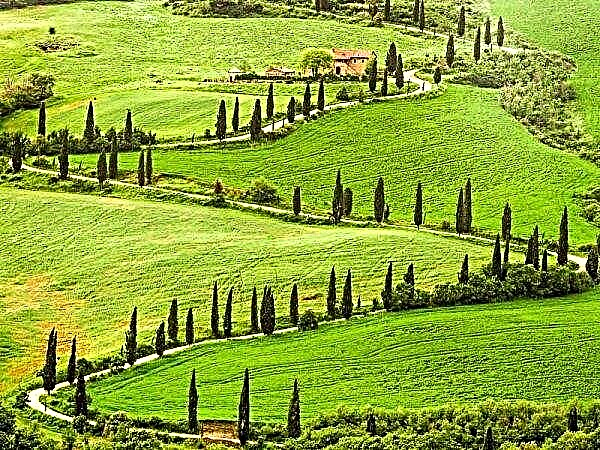Today there is a huge varietal variety of conifers, and when planting pine on their plot, each gardener has the opportunity to choose the most suitable option for themselves, both based on the external data of the plant and taking into account the peculiarities of caring for it. An ordinary Fastigiata pine is beneficial on both sides, and what exactly it is remarkable for and what are the minimum requirements for caring for it - this will be discussed later.
Botanical tree description
Pine Fastigiata (aka Pinus sylvestris Fastigiata) is a slow-growing medium-sized tree, which at the age of thirty reaches a height of 6–7 m and a trunk diameter of 1.2–1.5 m. However, such values are not final, and the maximum growth of the crop can be 13-15 m, with an annual gain of about 20-30 cm at the initial stages of cultivation and 10 cm after 30 years.

The crown of the plant is narrow, columnar in shape, with shoots pointing up (to many gardeners, Fastigiata pine resembles a candle). The bark of the branches and trunk is red-orange in color, in young plants is smooth, but with age becomes rough and begins to exfoliate with thin plates.
The blue-green needles are quite thick and hard to the touch, with the needles gathered in bunches (usually 2 pieces). Their life span is no more than two years, after which the needles turn yellow and fall.Pine flowering is from May to Juneafter which twisted yellow-red male spikelets appear (located at the base of young shoots).

Female specimens initially have a reddish hue with a greenish tint and are located singly on the top of the branches. Then they change their color to gray-brown, sometimes closer to black. Fruiting always remains plentiful. The root system penetrates deep into the earth, but only if the soil is well-drained and loose, while on heavy and dense soils the rhizome of the plant develops superficially.
- The following characteristics of plants can be attributed to the main characteristics of Fastigiata pine trees:
- high winter hardiness (adult trees withstand frosts down to –40 ° C);
- photophilousness;
- comparative unpretentiousness in leaving;
- drought tolerance and wind resistance;
- weak shoots, which during snowy winters can break off under the weight of adhering snow;
- low resistance to soil salinization, smoke and environmental pollution.
Important! The ordinary pine Fastigiata is not suitable for cultivation in smoky industrial regions and close to the busy roads of city streets. The ideal place for planting is the territory of suburban areas where it can be placed both in single and in group plantings, combining favorably with other coniferous and deciduous specimens.
Landing
The first thing to do before planting Fastigiata pine is to choose the most suitable site for the plant on the territory, taking into account its main requirements. The best option for placing ordinary pine of this variety is a place well-lit by the sun, covered from strong gusts of wind and characterized by increased soil moisture.

As for the composition of the substrate, almost any option with different acidity is suitable for the Fastigiata variety, although it is preferable to plant the plant in sandy loam or sandstone. Excess humus pine does not tolerate well, therefore it is not necessary to fertilize the soil excessively, as well as its overmoistening with the possibility of flooding the root system of the pine.
The best time for pine planting is from late April to early May or from late August to mid-September. In group plantings between adjacent plants of the Fastigiata variety, it is worth maintaining an interval of 2 m.

The planting process itself is simple and involves the implementation of standard actions:
- Preparing the landing pit. The selection of its size is carried out taking into account the parameters of the rhizome of the selected seedling (together with an earthen lump). The best option in this case would be 80 × 80 cm.
- Organization of a 20-cm drainage drainage layer (broken brick or expanded clay can be used) and filling the hole with a suitable soil mixture for 1/3 of its total volume. You can use a mixture of forest substrate, chernozem soil and mineral fertilizers, and in the latter case, at least 100 g nitroammophoski will be required per plant. Some gardeners recommend adding a little more regular oats to the planting pit, which will help young plants to take root in a new place faster.
- Transferring coniferous seedlings from a temporary container to the prepared hole using the transshipment method. If the pine is hard to remove from the box, then you have to water it abundantly and wait until the soil is slightly wet, and only after that try to get the seedling.
- Backfill the landing pit with the remaining soil and a good compaction of the earth in the near-trunk zone so that it fills all the air pockets between the individual roots.
- Watering and mulching the trunk circle.
 When placing the plant in the hole, make sure that its root neck remains at ground level or slightly rises above it.
When placing the plant in the hole, make sure that its root neck remains at ground level or slightly rises above it.
Pine care
Caring for an ordinary pine Fastigiata is based on all the same actions as growing other varieties of conifers - timely watering, feeding the tree, as well as loosening and mulching the soil. In addition, crop pruning, as well as the prevention of diseases and pests, will not be in the last place.
Watering and feeding
Pine Fastigiata refers to drought tolerant plants, therefore, watering will be especially important for young newly transplanted seedlings. In the first 2-3 years after landing on the site, the regularity of this procedure is usually 1-2 times a week, but always taking into account weather conditions.
Subsequently, in the summer period, the introduction of fluid is reduced to 1 time per month, periodically performing sprinkling of the crown (only in the evening after sunset). When preparing a plant for wintering, 2-3 weeks before the expected frosts, water-charging irrigation is performed, in which at least 20 liters of settled liquid is consumed per 1 pine.
 As for top dressing, a universal complex fertilizer for conifers will be a good solution, which should be applied in the early spring, shortly after the last snow has melted. It is better not to use organics, with the exception of the autumn mulching of the trunk area with rotted compost.
As for top dressing, a universal complex fertilizer for conifers will be a good solution, which should be applied in the early spring, shortly after the last snow has melted. It is better not to use organics, with the exception of the autumn mulching of the trunk area with rotted compost.
Loosening and mulching
Each plant needs a sufficient supply of air to its root system, and when a hard coating appears in the near-trunk zone, this becomes physically impossible. It is for the destruction of the soil crust that the loosening procedure is necessary, which is usually performed several days after the next scheduled watering. Strongly deepen the rake is not necessary: it will be enough to loosen only 10 cm of the upper layer of the substrate.
In order to preserve moisture and nutrients in the soil for a long time, it is possible to mulch the loose soil with a layer of pine bark or wood sawdust, but no more than 5–10 cm above the soil surface. Mulch replacement is performed 1-2 times a season, a few days after the next watering and loosening procedure.
Did you know? Amber, popular in jewelry, is often the result of petrification of the resin of pine trees, therefore, in such coniferous forests there are much more opportunities to find this mineral.
Pruning
Fastigiata trees do not need frequent pruning and feel quite good in the case of rare sanitary or formative procedures. However, in order to achieve maximum decorative plants, this issue should be given due attention.

Removing frozen, broken and diseased branches during the winter is most often done in the spring., but if necessary, can be performed in the fall, after the leaves are not left on the trees. The crown formation of young pines is relevant only for one- or three-year-old plants and is also planned mainly for the spring period (can be combined with sanitary pruning).
The main requirement is normalized shoot removal: no more than 1/3 of the total volume of branches at a time. Of course, both the cutting tool itself and the place of cuts should be disinfected already at the end of the procedure, which will prevent infection from entering the deep layers of wood.
Possible diseases and pests
Conifers of the described variety are usually characterized by increased resistance to various diseases and pests of the culture, however, it is not worth completely eliminating the likelihood of damage by them.
Among the most common pine problems, there is infection with a pine subcorn bug, a butterfly of the shoot shoot of the Listovert family, as well as fungal diseases like snow shute, colorful yellowing of needles, bordered tinder fungus, and root sponge.

To prevent the spread of pests and ailments, at the first symptoms of their appearance on a pine tree, it is worthwhile to remove the affected parts of the plant, and treat the rest with a suitable fungicidal or insecticidal drug, popular among which are Skor, Topaz, Aktara, Fundazol or ordinary copper sulfate.
If the crown is damaged by diseases and pests, the simultaneous use of fungicides and insecticides is allowed: just make sure the compatibility of the selected compounds. For example, the popular drug "Aktara" can be combined with the fungicides "Skor" and "Topaz", and to increase the chances of success, such treatments are best done twice, with an interval of 3-4 weeks.
Did you know? Coniferous plants are excellent air purifiers. According to scientific studies, 60–70 thousand fewer microbes in a pine forest than in urban apartments.
The use of wood in landscape design
When planting greenery, Fastigiata pine can be used in a variety of roles: both as a tapeworm, and as an integral part of a group composition in rock gardens or when planting along fences.
The bluish-gray color of its needles favorably distinguishes the plant against the background of other crops, but it will look best next to heather, turf and potentilla. By combining the groups correctly, you can equally well decorate both small and large gardens.
In general, planting Fastigiata pine trees and taking care of it cannot be called a very difficult task, both for experienced gardeners and beginners in this matter. Subject to all the requirements for the planting process and further care for the tree, it will always delight you with the splendor and brightness of the crown, decorating any home area or garden.

